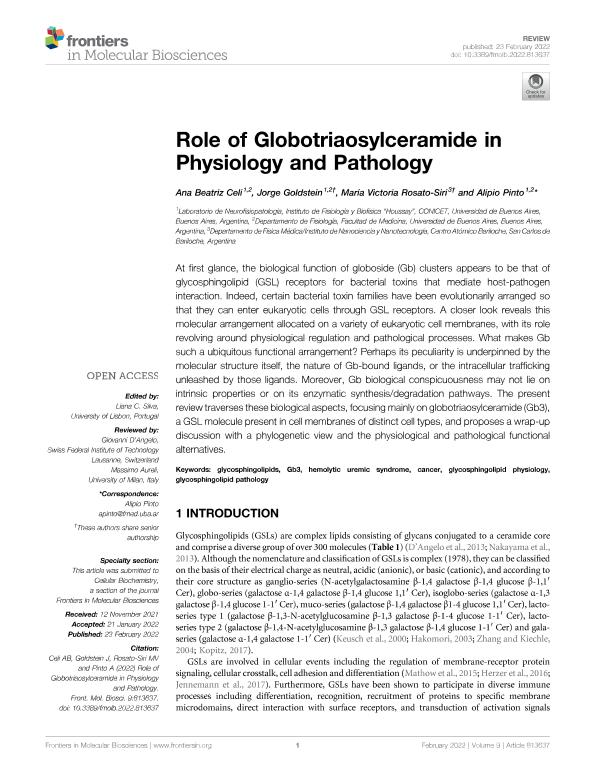Artículo
Role of Globotriaosylceramide in Physiology and Pathology
Celi Castillo, Ana Beatriz ; Goldstein Raij, Jorge
; Goldstein Raij, Jorge ; Rosato Siri, María Victoria
; Rosato Siri, María Victoria ; Vasconcelos Esteves Pinto, Alipio
; Vasconcelos Esteves Pinto, Alipio
 ; Goldstein Raij, Jorge
; Goldstein Raij, Jorge ; Rosato Siri, María Victoria
; Rosato Siri, María Victoria ; Vasconcelos Esteves Pinto, Alipio
; Vasconcelos Esteves Pinto, Alipio
Fecha de publicación:
02/2022
Editorial:
Frontiers Media
Revista:
Frontiers in Molecular Biosciences
ISSN:
2296-889X
Idioma:
Inglés
Tipo de recurso:
Artículo publicado
Clasificación temática:
Resumen
At first glance, the biological function of globoside (Gb) clusters appears to be that of glycosphingolipid (GSL) receptors for bacterial toxins that mediate host-pathogen interaction. Indeed, certain bacterial toxin families have been evolutionarily arranged so that they can enter eukaryotic cells through GSL receptors. A closer look reveals this molecular arrangement allocated on a variety of eukaryotic cell membranes, with its role revolving around physiological regulation and pathological processes. What makes Gb such a ubiquitous functional arrangement? Perhaps its peculiarity is underpinned by the molecular structure itself, the nature of Gb-bound ligands, or the intracellular trafficking unleashed by those ligands. Moreover, Gb biological conspicuousness may not lie on intrinsic properties or on its enzymatic synthesis/degradation pathways. The present review traverses these biological aspects, focusing mainly on globotriaosylceramide (Gb3), a GSL molecule present in cell membranes of distinct cell types, and proposes a wrap-up discussion with a phylogenetic view and the physiological and pathological functional alternatives.
Archivos asociados
Licencia
Identificadores
Colecciones
Articulos(IFIBIO HOUSSAY)
Articulos de INSTITUTO DE FISIOLOGIA Y BIOFISICA BERNARDO HOUSSAY
Articulos de INSTITUTO DE FISIOLOGIA Y BIOFISICA BERNARDO HOUSSAY
Citación
Celi Castillo, Ana Beatriz; Goldstein Raij, Jorge; Rosato Siri, María Victoria; Vasconcelos Esteves Pinto, Alipio; Role of Globotriaosylceramide in Physiology and Pathology; Frontiers Media; Frontiers in Molecular Biosciences; 9; 2-2022; 1-20
Compartir
Altmétricas



